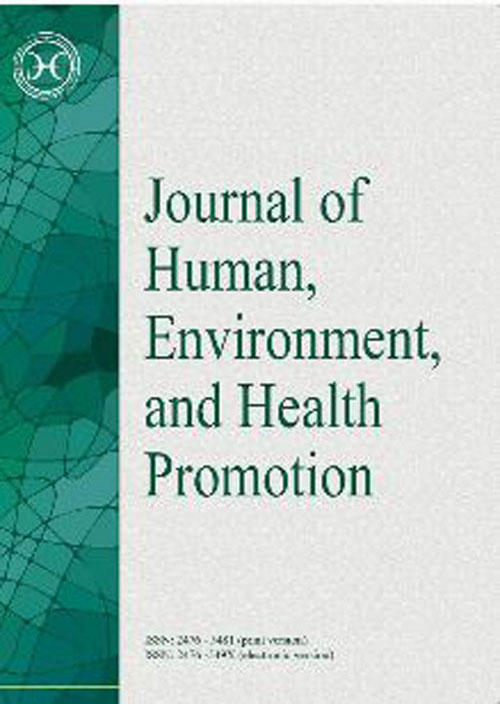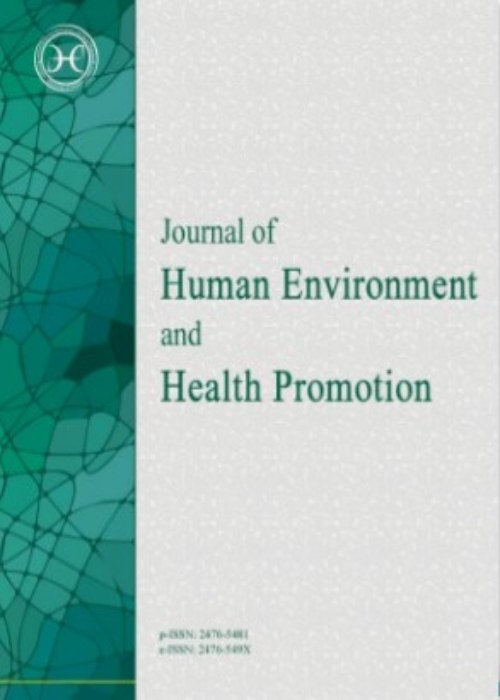فهرست مطالب

Journal of Human Environment and Health Promotion
Volume:6 Issue: 3, Summer 2020
- تاریخ انتشار: 1399/09/15
- تعداد عناوین: 8
-
-
Pages 101-105Background
Essential oils are volatile components which produced by different parts of the medicinal plants. These components have antibacterial potential and have been used throughout the world as a common, time-tested spice. The present study aimed to assess theantibacterial effects of cinnamon essential oil on several foodborne bacteria, including Staphylococcus aureus, Bacillus cereus, Listeria monocytogenes, Escherichia coli, Salmonella typhimurium, and Pseudomonas aeruginosa.
MethodsLiterature search was performed in databases such as PubMed, Google Scholar, SID, Scopus, ScienceDirect, and Elsevier to find the relevant articles published during 1987-2018 using keywords such as medicinal plants, cinnamon essential oil, foodborne diseases, and foodborne pathogens.
ResultsCinnamon essential oil has been reported to have several antibacterial components, which could inhibit the growth of some foodborne pathogens. Therefore, it could be used in foods, cosmetics, and hygienic industries alone or in combination with other antimicrobial agents to reduce the risk of contamination and increase the shelf life of foods.
ConclusionProper doses of cinnamon essential oil can be applied as a food preservative in the food industry as long as the taste of the food is not affected.
Keywords: Cinnamon, Essential oil, Antimicrobial effect, Foodborne diseases -
Pages 106-114Background
Food security is an alarming issue to researchers. This study aimed to evaluate the trace metals in fruits and vegetables and their impact on human health in Konabari industrial area (Gazipur, Dhaka, Bangladesh) during 2016-2017.
MethodsWet acid digestion determined the concentrations of eight trace elements (aluminum, calcium, iron, potassium, magnesium, manganese, sodium, and zinc) in 28 samples of 10 fruits and vegetables (papaya, guava, banana, Malabar spinach, eggplant, jute tender leaves, watercress, water spinach, gourd leaves, and cauliflower) using a microwave and inductively coupled plasma optical emission spectrometry. To assess the human health risk, the target hazard quotient (THQ) was calculated only for iron, manganese, and zinc in Microsoft Excel.
ResultsThe mean concentrations of aluminum, calcium, iron, potassium, magnesium manganese, sodium, and zinc were 764.2, 6664.6, 556.2, 3551.14, 4479.4, 1034, 1559.8, and 128.6 mg/kg, respectively, which decreased as Ca>Mg>K>Na>Mn>Al>Fe>Zn. Most values exceeded the total nutritional levels for these fruits and vegetables, while the estimated daily intake of the elements was acceptable. The THQ of the fruits and vegetables consumed by the adult population was <1.
ConclusionAs the THQ was <1, the consumption of the samples posed no major health risks in terms of the trace elements.
Keywords: Trace element, Heavy metals, Risk assessment, Fruits, vegetables contamination, Bangladesh -
Pages 115-120Background
Despite the health benefits of physical activity, many people still adopt sedentary lifestyles. This study aimed to investigate the effect of education based on trans-theoretical model (TTM) on physical activity of women of reproductive age in Zanjan.
MethodsThis was a quasi-experimental study. Using convenience sampling method, the sample size of 120 women was selected and randomly allocated to study groups. The data was collected using a short version of Physical Activity Change Algorithm Questionnaire and IPAQ (International Physical Activity Questionnair) before and 3 months after intervention. In addition to training sessions, the intervention 2 group was trained to use pedometer.
ResultsBefore the intervention most of the women were in contemplation and preparation stages and 3 months after the intervention, women in intervention groups moved to action and maintenance stages (P < 0.001). There was significant difference in mean time of weekly walking and physical activity in three groups 3 months after the intervention (P < 0.001). These changes were more prominent in women who used pedometer.
ConclusionThe findings showed that education based on the trans-theoretical model was effective in promoting the physical activity. Using the pedometer along with education had effect on improvement of the physical activity.
Keywords: Education, Trans-theoretical model, Physical activity, Reproductive aged women, Pedometer -
Pages 121-127Background
Healthcare systems are exposed to various occupational hazards (e.g., infectious diseases), which threaten the health and safety of the employees. This study, conducted in September 2017 aimed to outline a two-phased approach for the identification of the most important hazards accurately and rapidly and better decision-making in the next step of risk management.
MethodsThis two-phased study aimed to rank the most important hazards in the operating room of a hospital and identify the hazards using two methods (HAZID and ANP) consecutively. Data management was performed in the Super Decisions software.
ResultsIn total, 44 hazards were analyzed in three categories, and five hazards (occupational stress, formaldehyde exposure, shift work, poor posture, and exposure to anesthetic gases) had the highest priority. The normalized values of the alternatives obtained from a limit super matrix were 0.33, 0.251, 0.258, 0.096, and 0.06. Occupational stress was the most weighted hazard, while formaldehyde exposure was the least weighted hazard.
ConclusionUsing the two approaches of hazard identification helped us conduct new, rapid hazard identification activities and increased the accuracy of the process as well. As a result, the time-consuming risk assessment phase was focused on the most important hazards.
Keywords: Hazard identification, Healthcare professional, ANP approach -
Pages 128-133Background
Health, safety, environment (HSE) - management evaluation (ME) is a managerial tool used to control and improve the health, safety, and environmental performance in development programs and industrial projects or organizations. The present study aimed to evaluate HSE in the management of the hazardous wastes of an oil refinery in Tehran province, Iran based on the guidelines of oil and gas producers association OGP.
MethodsIn this cross-sectional study, a HSE questionnaire and a checklist were completed based on the basic information of the organization, HSE documentation, and interviews with those involved in HSE-ME and waste management. The questionnaire was prepared based on the OGP guide and validated by a panel of HSE experts.
ResultsThe refinery had favorable conditions, and all the items presented in the questionnaire were in the C and D ranges. In addition, the checklist results were indicative of favorable HSE and waste disposal conditions in the refinery. On the other hand, the physical, chemical, and biological risk of exposure to waste was not properly assessed in the company, which was a major setback to waste management.
ConclusionThe refinery employees had moderate knowledge level regarding HSE-ME. Therefore, attempts must be made by the management of the organization in order to improve the issue through correct policies.
Keywords: Hazardous Wastes, HSE-ME, Oil Refinery -
Pages 134-141Background
Considering the shortcomings of the government and donors’ background, public participation in the development of the healthcare system is an essential strategy in national social development. The present study aimed to evaluate the influential factors in donor participation.
MethodsThis applied, descriptive-correlational study was conducted on 230 donors in Iran during 2018-2019. Data were collected using a researcher-made questionnaire, and its internal consistency was evaluated using the Cronbachchr('39')s alpha coefficient. Data analysis was performed in SPSS version 26.
ResultsIn total, 70.9% of the participants were male, and the remaining were female. Self-employment was reported in 59.2% of the participants, and the others were government employees. The most significant correlations were observed between volunteering (r = 0.776) and religious beliefs (r = 0.644) with donor participation, while the least significant correlation was between social awareness and donor participation (r = 0.121). No significant associations were denoted between education level, income status, and donor participation.
ConclusionAccording to the results, the most important influential factors in donor participation were volunteerism and religious beliefs. Therefore, it is recommended that policymakers and decision-makers pay special attention to the importance of donor activities in the healthcare system.
Keywords: Healthcare system, Donors, Participatory action, Charity medical center, Sociology -
Pages 142-146Background
Gastrointestinal infections in ruminants are a major cause of economic losses. The present study aimed to evaluate the prevalence and seasonal variations of gastrointestinal helminth parasitic infections in the slaughtered animals in Mazandaran province, northern Iran.
MethodsThis descriptive study was conducted on 300 cattle ruminants (sheep and goats) in Mazandaran province during September 2015-March 2017. The animals were assessed using parasitological methods. The contents of abomasa, small intestine, muscles, and liver were evaluated macroscopically and microscopically.
ResultsAmong 300 ruminants, 178 (59.33%) were positive for various species of gastrointestinal helminthes, including T. colubriformis, O. circumcincta, M. marshalli, H. contortus, Habronema spp., P. skrjabini, T. saginata, Echinococcus spp., Fasciola spp., and Dicrocoelium spp. Babol was the most infected city (P = 0.001), and spring and summer had higher infection rates. Females were significantly more infected than males, and the animals aged more than nine months were infected more commonly than younger animals (P < 0.05).
ConclusionAccording to the results, the rate of gastrointestinal helminth infection was relatively high among the slaughtered ruminants in northern Iran in terms of economic and zoonotic importance, which threatens animal production and public health.
Keywords: Helminthes infections, Ruminants, Abattoir, Iran -
Pages 147-152Background
Sleep disorders adversely affect human health. The present study aimed to compare the sleep patterns of menopausal and non-menopausal women.
MethodsThis case-control study was based on the data of the first phase of Shahedieh cohort study in Yazd, Iran during 2015-2016. The case group included menopausal women (n = 1,709), and the control group included non-menopausal women (n = 3,121). The study variables were assessed by the questions regarding the menopause status and sleep. Data analysis was performed in SPSS version 20.
ResultsThe sleep duration of the menopausal and non-menopausal women was 7.1 ± 1.3 and 7.4 ± 1.3 hours, respectively (P = 0.001). Most of the menopausal women reported the restless legs syndrome during sleep, naps during the day without specific activity, and using sleeping pills more than twice weekly. After adjusting the effect of the other variables, the possibility of the sleep duration of less than six hours or more than eight hours in the menopausal women was 13 times higher than the non-menopausal women, while the correlation was not considered significant (OR = 1.13; 95% CI = 0.98-1.29; P = 0.07).
ConclusionThe prevalence of sleep disorders (e.g., sleep latency, restless legs syndrome, naps during the day, use of sleeping pills) was higher in the menopausal women.
Keywords: Sleep, Menopausal, Women


